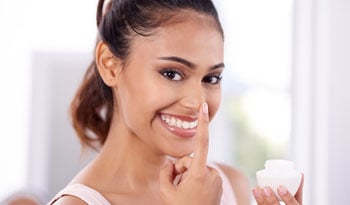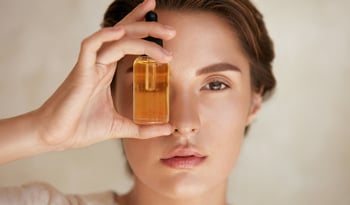Skincare Advice for Those Staying at Home Most of the Time
DESCARGO DE RESPONSABILIDAD:Este blog no pretende proporcionar diagnóstico...
- En este artículo:
- The Effect of Behavior and Mood on Your Skin
- Blue Light (Visible Light) and Your Skin
- How Air Moisture Affects Your Skin

We may not be in full lockdown mode anymore, but many of us are still working from home, getting groceries delivered, and avoiding large social gatherings. As such, many of us are spending more time indoors. And with everything going virtual, it seems like screen time is skyrocketing. We’ve probably all been feeling the mental and physical effects of these changes in our environment and activities, but have you considered how it may be affecting your skin as well?
Our skin is sensitive to changes in our environment due to differences in temperature, humidity, pollution, and light. For example, you may have noticed how your skincare needs change in different seasons (like becoming drier in the winter), or after traveling. Therefore, it should be no surprise that being in the house more often can lead to changes in your skin as well.
When considering these recent changes in our lifestyles, I would like to highlight what I think are the most important considerations for your skin and skincare needs while spending more time indoors: mood and behavior, blue light (visible light), and air moisture content.
The Effect of Behavior and Mood on Your Skin
Let’s be honest. Many of us have been spending the day in our pajamas while we take conference calls, attend virtual lectures, and learn to bake bread (if you were lucky enough to find yeast). Without the normal daily rituals of getting ready and going to work, school, or social hangouts, it can be easy to let our normal skincare routines slip as well. In my opinion, now is actually the best time to focus on honing our skincare regimens.
In times that feel challenging and confusing, having the stability of a structured skincare routine can actually be comforting and help us to focus on wellness and self-care. In addition, because we are away from people and distractions, we have more time to focus on nailing down good habits, which can benefit us in the long term.
Another consideration is that for some skincare products (such as topical retinoids), the skin may break out and get a little bit worse initially before it gets better. In this case, this could be a unique opportunity to trial a new product for several weeks, without having to see a lot of other people.
The other important piece of this is mood. Because we are facing a lot of frustration, uncertainty, and time away from friends and other humans, some people are feeling more anxiety, stress, and depression. It is well established that our mental and emotional state is linked to our physical body, and the skin has a unique connection with the mind because the cells in the skin are derived from the same embryologic layer as neural tissues, such as the brain and nerves. So what does this mean? It means that when people are experiencing higher levels of emotional stress, they could be more prone to experiencing acne or rosacea breakouts, or flares in skin conditions such as psoriasis, eczema, or other autoimmune conditions.
For acne breakouts, I recommend looking for products that contain benzoyl peroxide or salicylic acid. I like the Neutrogena Rapid Clear Stubborn Acne Daily Leave-On Mask and the Neutrogena Oil-Free Acne Stress Control Power Cream Wash. If breakouts are severe, though, it could be time to see a dermatologist, because some acne needs prescription medications to clear it up, and it’s better to treat it earlier to avoid scarring.
For stress reduction, products that contain feverfew, calendula, lavender, or chamomile all can have a calming effect. You can find these ingredients in teas, oils, moisturizers, and many other products. The main thing to be aware of with these ingredients (like any plant-derived component), is that sometimes people can develop allergies or irritation from them when applied topically to the skin, particularly eczema patients with sensitive skin.
Blue Light (Visible Light) and Your Skin
These days, most people understand that UV light from the sun is damaging to our skin, and is one of the most well-known contributors to skin cancer and skin aging. But what a lot of people don’t realize is that visible light (such as the lights in a building or from a screen), can also contribute to aging and hyperpigmentation of the skin.
What!? So just when you thought you were off the hook by being indoors, I’m here to tell you that even while you’re sitting at home, you still need protection.
Let me explain. At all times, our bodies are exposed to electromagnetic radiation through a variety of different wavelengths being emitted from different sources. Many of these wavelengths we cannot see, like radio waves, x-rays, and UV rays.
There is a small range of electromagnetic radiation that is emitted from wavelengths that we can see, and this is referred to as the “visible light spectrum.” These wavelengths are also emitted from the sun. However, unlike UV rays, visible light also comes from fluorescent and incandescent lights (like those in our homes and buildings), and computer screens. It is increasingly being understood by scientists and researchers that visible light, particularly in the blue light range, can actually induce stress in the skin, leading to hyperpigmentation and aging.
Therefore, even while we are indoors, we still need coverage. However, most commercially available sunscreens only provide UVA/UVB coverage, and not visible light coverage. That’s why it’s important to find a sunscreen that also contains iron oxides, which is best at combatting visible light. Iron oxides are often found in tinted sunscreens, and in makeup.
I recommend using a tinted sunscreen or using a lightweight, non-comedogenic makeup to apply over your daily SPF, so you can get the added protection from visible light. This is especially important for people with melasma, or brown spots/patches on the skin because visible light can make it worse.
Another tactic that is being actively researched to fight damage caused by visible light is topical and oral antioxidants. Some antioxidant ingredients that have been demonstrated to combat the oxidative stress caused by visible light include a combination of feverfew, soy extract, and vitamin E combined into a sunscreen, cocoa peptides, and oral polypodium leucotomos.
Some of the products I like that provide good visible light protection include Badger Company Mineral Lip Tint, Derma E Essentials Sun Protection Mineral Powder (SPF 30), and Physicians Formula Super BB All-in-1 Beauty Balm Cream (SPF 30).
How Air Moisture Affects Your Skin
The final component of being indoors that I want to highlight is the air humidity. In general, the moisture levels in the air are thought to be lower than outside. In addition, when we are indoors, often we use heaters or air conditioners with forced air. Lower air humidity levels have been demonstrated to affect how our skin holds onto moisture and stays hydrated, so people may notice that they tend to have more dry, sensitive skin, or worsening of their eczema in times when they are indoors more frequently, such as in the winter or during the pandemic.
There are a couple of ways to combat this. One is to get a humidifier for the house, in order to increase the water content levels of the air inside. Another crucial strategy is to moisturize, moisturize, moisturize.
It’s important to invest in a good cream or ointment moisturizer for the body, and a gentle moisturizer for the face. For nighttime facial moisturizers, I personally love using either the CeraVe PM Facial Moisturizing Lotion or the Cetaphil Rich Hydrating Night Cream with Hyaluronic Acid. For the body, I love the CeraVe Moisturizing Cream; it works really well and doesn’t feel too greasy. The best time to moisturize is right after showering, and I always tell people to pat the skin dry and leave it slightly damp before applying the moisturizer. By doing so, it will help lock in the moisture.
I hope these tips for skincare while staying indoors were helpful. Good luck!

 Por Dra. Afton (Chavez) Cobb, doctora en medicina, Miembro de la Academia Americana de Dermatología
Por Dra. Afton (Chavez) Cobb, doctora en medicina, Miembro de la Academia Americana de Dermatología


